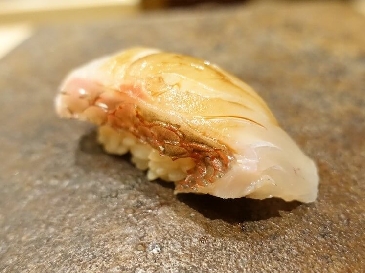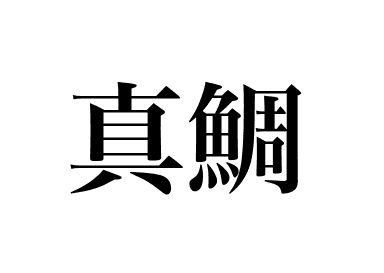White flesh


Red seabream (Tai)
【Nigiri sushi: Shiromi】
What is Red seabream (Madai)?
Red seabream is the most widely distributed species of seabream in Japanese coastal waters, found throughout Japan except for parts of Hokkaido and the Ryukyu Islands, as well as along the coasts of the Korean Peninsula, China, and parts of Southeast Asia. Adult fish inhabit rocky reef areas at depths of 30–200 meters and the surrounding sandy-mud bottoms. While they can grow to over 1 meter in length, most individuals are typically less than 50 centimeters long.
The body is elliptical in shape, flattened laterally, and has a high body height. The body is pale reddish in color, becoming lighter toward the abdomen, with small, vivid cobalt-blue spots scattered across the upper portion of the body sides. Another distinctive feature is the black edge along the rear margin of the caudal fin.
There are about 3,900 known fish species in Japan, and of those 360 have a Japanese name ending in “-tai/dai”. However, only 13 of those belong to the most major “tai” family. Some of those are madai, chidai, kidai, and kurodai. The most familiar fish named like this, such as ishidai, kinmedai and ebodai, actually has nothing to do with the tai family.
What does Madai (Red seabream) nigiri sushi taste like?
Red seabream has been loved in Japan since ancient times, with the saying, “Flowers are cherry, fish are sea bream”. It is revered as an auspicious fish due to its bright red body and the word association of “madai” (red seabream) and “medetai” (celebratory). The custom continues of eating it, complete with head and tail, at celebrations and festivals such as weaning ceremonies and weddings.
It is known for its savory flavor, firm texture and very tasty flesh and considered to be the king of white fish. There are two ways to enjoy Madai, either served skinless to enjoy the concentrated sweet flavor of the white flesh, or as Matsukawa-zukuri, parboiled with the skin. The customer has an opportunity to savor the flavor of the entire fish, the skin, the fat under the skin, and the white flesh. Sea bream is served between winter and spring, the spawning period. There is one red seabream that recurrently migrates on the coast of the Seto Inland Sea for spawning, called Sakuradai (cherry blossom sea bream), which is especially delicious and highly valued. Meanwhile, once the spawning is complete and the fish loses its flavor, it’s called Mugiwaradai (barley straw seabream).
The madai with the most umami has been caught using the Ikejime process, then stored in icing storage for a day where it is gradually cooled and matures evenly, bringing out a high amount of umami. For farmed tai, using ikezukuri once it’s caught allows it to be eaten without the peculiar aquaculture flavor. In other words, farmed tai is not suitable as a sushi topping that requires aging.
In general, many sushi restaurants in Kanto prepare tai as their white fish topping. It’s safe to assume that if you request sushi with a white fish topping, you will get either tai, hirame or karei. However, in Tokyo it’s hard to get ahold of tai that is as delicious as the tai caught in the Seto Inland Sea of Japan, so some sushi restaurants opt to not make tai sushi. The famous Sukiyabashi Jiro is one such restaurant.
The sweetness of red sea bream comes from the high content of glycine, which is an amino acid. The glycine content in sea bream meat is approximately 140 to 180 mg per 100 g, much higher than the 50 mg per 100 g in tuna meat. It also only contains 350 mg per 100 g of inosinic acid, the umami component of fish meat, which is low compared to the 420 mg per 100 g found in bonito. This ratio means that the sweet flavor is emphasized more than the richness.
Tai (Red seabream) is often said that they are tastier when they weigh around 2kg and their length is about 40 to 50cm.
Also called Red snapper or Snapper Sea bream or Genuine porgy or Porgy.
【Substitute fish】
Nile tilapia (Izumidai): Oreochromis niloticus (Linnaeus,1766)
Channel catfish: Ictalurus punctatus (Rafinesque, 1818)
【Farmed red seabream】
The annual production of farmed Madai (Red seabream) in Japan is estimated at 50~60,000 tons. And these cultured red seabream fry are supposedly all "of Kindai-Madai blood". Kindai-Madai refers to a breed that originated at the Kindai University experimental station.
Kindai-Madai grows nearly twice as fast as the natural species, reaching a weight of 2 kg in about three years from eggs. Kindai University began breeding in the 1960s, using "selective breeding," in which fast-growing fry are selected and bred repeatedly, and by the 1990s, after eight generations, the current characteristics had been established.
Kindai continues to contribute to the development of the red seabream aquaculture industry by shipping its fry, which are improved year by year, throughout Japan, and currently ships 14-15 million artificial fries annually.
【Trivia】
Red seabream is recognized in Japan as a top luxury fish. In the Edo period, it was even offered as a gift to the Tokugawa shogun. In China, however, it is said to be a "fish that eats the flesh of the dead. " In France, it is called "the greedy lower fish" and is of low value.
【Related contents】
What is hybrid artificial fish?
What is Red Snapper the same as “Tai” (Sea Bream)?
What is traditional Ikejime?
What is Pacific barrelfish (Medai) sushi?
What is Izumidai?
List of White flesh fish (Shiromi)
(Revision date: May 27, 2025)
Main production area
Setonaikai Nagasaki Kumamoto Kagoshima
Famous production area
Akashi Sajima Awaji Island Genkai-nada Sea Kada
Season
Winter-Early spring

